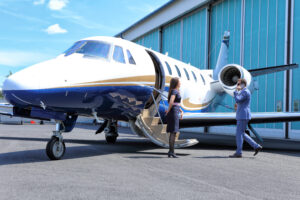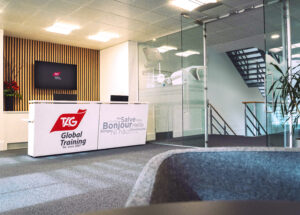Companies operating within the business aviation sector are finding it increasingly difficult to attract, develop and retain the best talent.
A decline in uptake for careers in aviation has created a challenging hiring market, so it’s more important than ever that businesses operating in the industry do their best to retain their workforces – and create an environment that entices new talent, too.
Initiatives that boost employee engagement are crucial. This is where training can play a key part in retention – and job hunters increasingly want to see a path for professional development prior to joining a company.
A hiring tool

TAG Global Training (TGT) was established in 2007 to support pilots and cabin crew in their regulatory ground school elements. Its ethos is that the more engaging and relaxed a learning environment is, the more likely people are to learn effectively – and its team of highly experienced instructors who are passionate about learning and aviation help to achieve this.
“Prospective candidates want to see an organization’s values and that includes personal development opportunities,” says Lesley Coleman, TAG global training manager at TAG Aviation.
“I am a strong advocate of lifelong learning. Learning is within all of us, fostered by our natural instinct to grow both personally and professionally. I believe it is essential that we recognize the value our people bring to an organization.”
Emre Eröktem is senior lecturer and program director of aviation management at City St. George’s, University of London. He believes training offerings and employee engagement initiatives are essential for both attracting and retaining the best talent in business aviation.
“Organizations that foster career planning and development for staff as well as promoting staff buy-in to the corporate vision, mission and strategy will likely be sought after by potential employees,” says Eröktem.
“A structured staff training and development strategy, overseen by senior leadership and with the coordination of HR, is key. Examples of such strategies are apprenticeship schemes, sponsoring of staff undertaking taught MSc and research PhD degrees, and ad-hoc collaboration between industry and higher education providers, to name just a few.”
Eröktem adds that close links between industry and academia are essential for meeting the
needs of aviation professionals and their organizations.
Invest to engage
Last year, Los Angeles World Airports (LAWA) partnered with experience innovation consultancy Designit to launch a proprietary digital airport worker experience solution called Altitude. The solution, which is also deployed within private terminals, aims to support staff by providing better tools, services and information across Los Angeles International Airport (LAX).
The tool includes an FAQ feature that helps workers answer passenger questions, the ability to quickly report problems within terminals, and also gives access to discounts on and off campus and commuter options.
“Worker experience solutions like Altitude play a huge role in work environments,” says Madeline Kossakowski, executive design director at Designit. “Having a central tool for all employees to access helps to create a sense of community and demonstrates the support an organization has for their employees.
“By creating tools that better enable employees to do their job and improve their overall experience, we are able to see increased engagement and satisfaction.”
In addition to providing support for employees to assist passengers, Altitude also allows LAWA to engage with LAX staff through its news hub, where key communication and information from LAWA can be shared with all employees easily.
Utilizing staff input

Investment in employee engagement like this is important to staff. Engagement fosters a positive work environment where employees feel valued and motivated, reducing turnover and enhancing overall performance.
This mindset can also be applied to the creation of training programs and related opportunities. Involving staff in the building of training programs helps companies to understand what their workforces need and the best way to engage with them.
“Staff should be involved in training program creation wherever possible,” says Carol Leaman, CEO and co-founder of Axonify, a workforce enablement solution that helps to train frontline staff.
“Whether it is gathering their feedback on knowledge gaps or having them measure how confident they are with their current knowledge, their firsthand experience and insights help ensure programs are relevant, effective and address challenges they actually face on the job.”
Leaman believes that including staff opinions in training plan builds also leads to increased engagement, a sense of belonging and importance, and in turn, better learning outcomes.
Training design

Once companies have the feedback of staff, business leaders can explore how they want to build out their training programs. Leaman believes the most critical training programs develop core technical skills, ensure regulatory compliance and instill a strong safety culture.
“In business aviation specifically, it’s vital to include training on providing exceptional customer service tailored to the needs and expectations of travelers,” she adds. “Above all, the training must be highly relevant, accessible and easy to understand.
“Aviation workers are always on the move, so being able to quickly learn and retain important information will keep the workers, the company and the customers happy.”
It’s important that business aviation companies are mindful that their more general training programs can be accessed by all members of staff – and that each department has separate training for their specific role too.
This can be rolled out in numerous ways, but utilizing new technology is a great method for engaging staff in this training.
“We recognize that having a wide audience, multiple locations and a diverse generational mix amongst our organization and our client base means that technology must be accessible to all,” says Coleman.
“We are continually innovating in this area, looking at how immersive learning and VR can be best utilized. TAG Aviation training is available online, via mobile devices and face-to-face.”
When it comes to engagement through technology, Coleman adds that there are platforms for company news within the online TAG Aviation environment where each department can share updates.
“This ensures the same messages are cascaded across the whole business simultaneously,” she says.
Best practice
![]()
For business aviation, collaboration and input with external bodies can increase the effectiveness of training programs. This approach ensures content is up-to-date and directly relevant to the trainees.
At City St. George’s, University of London, for example, its MSc in Aviation Management was launched with input from the Honourable Company of Air Pilots, approved by the Royal Aeronautical Society, and supported by the industry through links to bodies such as Airports
Council International and the British Business and General Aviation Association.
“Training that is matched to staff interests is popular, and can range from tailored individual short courses for continuing professional development all the way through to full MSc level degrees depending on requirements,”
adds Eröktem.
Leaman believes best practices in training include offering professional development opportunities, yearly retraining and ongoing reinforcement of knowledge on essential skills and regulatory requirements – plus adaptive programs to address skill gaps.
“Effective mentorship involves both formal programs to connect experienced and new employees, and open lines of communication between leaders and their direct reports,” says Leaman.
“Regular two-way feedback, clear performance expectations and transparency boost trust within teams and the organization and help foster a more engaged, informed and dedicated workforce.”
There is no one-size-fits-all solution to creating training programs and employee engagement initiatives within business aviation, but ensuring a company has a well-researched, informative and clear program in place is an essential piece in the puzzle of retaining the best talent and attracting more people to the sector.
“We believe that investing in employee experience helps to create better working cultures, resulting in positive business outcomes and better end-user experiences,” explains Kossakowski.





